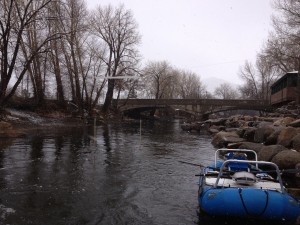I gave up waiting for the wind to stop blowing. The days were getting warmer, and sooner or later the river will blow out and become unfishable for a week or two. I decided to head upstream from town to a place where the river widened out and braided around a few small islands. With the tea-colored water already running over 1000 cfs, I wanted to find somewhere where a fish could seek respite from the full force of the current, and braids, side channels and slower water along cut banks seemed like a good bet.
The first couple of pools I fished were uneventful, then looking upstream I spotted a side channel with several swallows working the surface. Nothing was rising, but it seemed like a likely scenario to find a feeding fish. After a few casts with a dry fly only, I tied on a bead head – when in doubt, tie on a pheasant tail should be one of the Angler’s Ten Commandments – and was rewarded first cast with a nice brown lying in some slack water below the main seam of the channel. Two casts later, and another smaller brown, sitting in front of a large, submerged rock. I fancied myself as Archimedes in the bath – I’d just cracked the code, and the best of the run was yet to come.
As usual, little did I know. I fished up through the meat of the run, working it over carefully, without sight nor sign of another fish. I could have tried a different fly, or fished deeper, but I’m lazy that way. I tie enough knots guiding to want to spend an afternoon doing it for myself. With the wind seeming to let up, I moved downstream a quarter mile to take advantage of some cut banks in a place more exposed to the elements. With the river having been so low only a few weeks ago, there is an increased likelihood when fishing the shallows of snagging on grasses, weeds and twigs that were until recently high and dry. So it proved. No fish took my offerings, but I caught plenty of snags. Then, near the top of the run, I noticed casting was becoming more difficult, even though the wind was receding. It was then I noticed the tip of my rod hanging forlornly from the line, neatly severed below the first line guide.
The mystery is why, given the delicate nature of today’s graphite rods, such things don’t happen more often. That’s why you buy rods with lifetime replacement warranties, and always take an extra along. I thought of the spare lying in the back of my truck, a couple of hundred yards away. Nah, I’d had my fun. Time to head home for an afternoon beverage.



